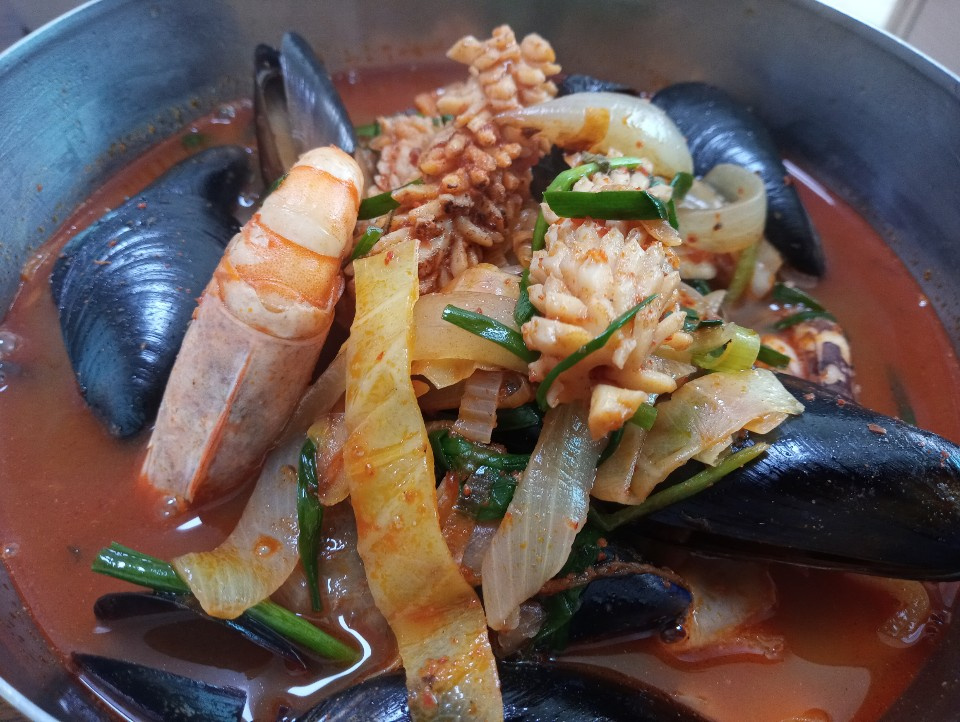Spicy Jjamppong at Home: Way Better Than Takeout!
Still Ordering Jjamppong? Make it Yourself!

Many people think Jjamppong or Jjajangmyeon are difficult to make at home, but they’re surprisingly simple and quick! A bowl of Jjamppong, simmered with plenty of seafood and vegetables, boasts a depth of flavor that rivals takeout. While there’s no single ‘secret’ ingredient, I’m sharing my personal tips and tricks so you can easily recreate this delicious dish at home. Prepare a satisfying meal with a warm bowl of freshly made Jjamppong!
Ingredients (Serves 2)- 1/2 Onion (about 100g)
- 100g Napa Cabbage (similar amount to onion)
- 100g Bok Choy
- 15cm Green Onion
- 5 cloves Garlic
- 1 knob Ginger (about the size of one garlic clove)
- 3-4 Dried Red Chilies (adjust to your spice preference)
- 1/2 Squid
- 4 Shrimp (peeled and deveined)
- 16-20 Mussels (cleaned thoroughly)
- 2 servings Chinese Noodles (frozen or fresh)
- 4 Dried Wood Ear Mushrooms
Seasoning- 2 Tbsp Gochugaru (Korean chili powder)
- 4 Tbsp Chili Oil
- 1 tsp Sesame Oil
- 1 Tbsp Soy Sauce
- 1.5 Tbsp Oyster Sauce
- Pinch of Black Pepper
- 2 Tbsp Cooking Wine (Mirin)
- 1 tsp Chicken Stock (or dashi stock, optional)
- 2 Tbsp Gochugaru (Korean chili powder)
- 4 Tbsp Chili Oil
- 1 tsp Sesame Oil
- 1 Tbsp Soy Sauce
- 1.5 Tbsp Oyster Sauce
- Pinch of Black Pepper
- 2 Tbsp Cooking Wine (Mirin)
- 1 tsp Chicken Stock (or dashi stock, optional)
Cooking Instructions
Step 1
First, cut the green onion lengthwise into 4 pieces, then slice into approximately 0.5cm thick pieces. Finally, chop these into roughly 0.5cm x 0.5cm squares. This size helps release the green onion’s flavor into the broth.

Step 2
Thinly slice the garlic and ginger into slivers. If using chives, cut them into 5cm lengths and set aside.

Step 3
Soak the dried wood ear mushrooms in lukewarm water for at least 10 minutes until fully rehydrated. Rinse them lightly under running water.

Step 4
Soak the dried red chilies in lukewarm water for about 10 minutes. This softens them, preventing burning and enhancing their aroma when stir-fried. Once softened, cut them into large pieces.

Step 5
Thickly slice the onion into strips about 1cm wide. Cutting them this thick maintains a pleasant texture and brings out their sweetness when cooked.

Step 6
Cut the napa cabbage into strips of similar thickness to the onion, about 1cm wide. The cabbage adds a lovely sweetness and refreshing element to the Jjamppong broth.

Step 7
Prepare the seafood. For the shrimp, simply remove the beards and wash them. For the mussels, scrub off any barnacles or grit and rinse under running water. For the squid, remove the skin and make shallow criss-cross cuts on the inside before slicing into 4x5cm pieces. These cuts make the squid more tender and visually appealing when cooked.

Step 8
Now, let’s stir-fry. Heat 4 tablespoons of chili oil in a wok or deep pan over medium-low heat. Be careful not to let the chili oil burn, which can happen over high heat.

Step 9
Once the chili oil is warm, add the chopped green onions, sliced garlic, ginger, and the rehydrated dried chilies. Stir-fry slowly over medium-low heat, allowing the aromatics to infuse the oil thoroughly without burning. This step is crucial for the deep flavor of the Jjamppong.

Step 10
Once the aromatics are fragrant, add the vegetables: sliced onions, napa cabbage, and rehydrated wood ear mushrooms. Increase the heat to medium-high and stir-fry quickly until the vegetables begin to soften slightly.

Step 11
As the vegetables start to cook, add all the prepared seafood (squid and shrimp) and stir-fry briefly. Avoid overcooking the seafood, as it can become tough. Cook just until it turns opaque.

Step 12
After stir-frying the seafood for about 30 seconds, add 2 tablespoons of gochugaru and mix well with the ingredients. Stir-frying the chili powder in the oil releases its spicy aroma. Once the seafood starts to cook through, add 2 tablespoons of cooking wine (mirin) to help eliminate any fishy odors.

Step 13
When the cooking wine has mostly evaporated, pour 1 tablespoon of soy sauce along the sides of the pan. This caramelizes the soy sauce, adding a ‘wok hei’ (breath of the wok) flavor. Immediately add 1 cup (about 200ml) of water and bring it to a boil.

Step 14
Once the broth begins to boil, add the remaining 3 cups (about 600ml) of water and bring it back to a rolling boil over high heat. As it boils again, add the cleaned mussels, 1.5 tablespoons of oyster sauce, and 1 teaspoon of chicken stock (or dashi stock). Continue to boil until the mussels have opened.

Step 15
When all the mussels have opened, add the bok choy and the chopped chives (if using). Simmer for another minute. Finally, stir in 1 teaspoon of sesame oil and a pinch of black pepper. Your flavorful Jjamppong broth is ready!

Step 16
Cook the noodles while the Jjamppong broth is finishing. In a large pot of boiling water, add the frozen Chinese noodles and cook for about 1 minute to thaw and heat through. If using fresh noodles, follow the package instructions for cooking time.

Step 17
Drain the noodles and immediately rinse them under cold water to remove excess starch, which keeps them springy and prevents them from getting mushy. Drain well. Divide the noodles into serving bowls.

Step 18
Ladle the hot, spicy Jjamppong broth and generous amounts of toppings over the noodles in each bowl. You’ve now created a delicious homemade Jjamppong! Enjoy your meal!



